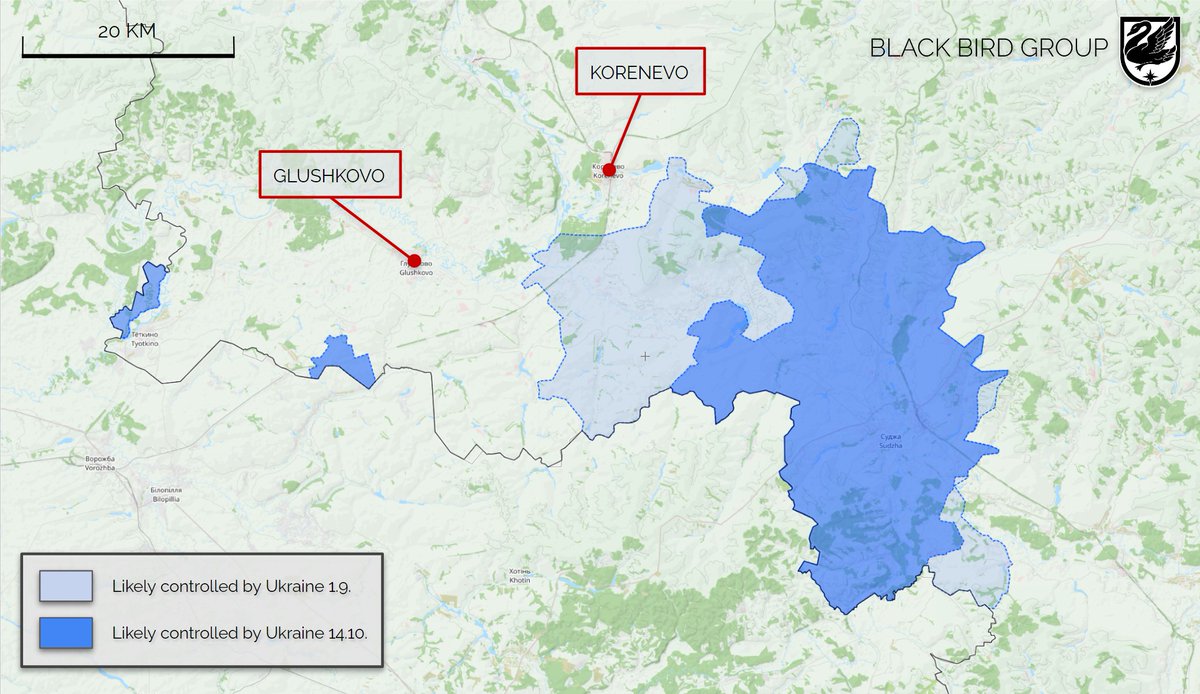The Russians recently launched a large offensive in eastern and southern Donetsk, on a 70 kilometers wide front.
The attack has breached Ukrainian defences in just a few days in many areas, and there can be some dangerous developments ahead, which I’ll discuss in this thread. 1/
The attack has breached Ukrainian defences in just a few days in many areas, and there can be some dangerous developments ahead, which I’ll discuss in this thread. 1/

The operation has two main focus areas, the Selydove-Kurakhivka area and the southern direction, where the enemy is currently advancing in the area between Shakhtarske and Bohoyavlenka. Both directions have their own problems and threats. 2/ 

In a short timeframe, Ukraine has very likely lost Selydove (over 21 000 pre-invasion residents), which is the largest city Russia has captured since the fall of Avdiivka. Simultaneously Russians also captured Hirnyk (10 000 pre-invasion residents). 3/ 

The Russians are now continuing east, and are likely trying to create an encirclement threat to force the Ukrainians to retreat from Kurakhivka. If they’re able to advance to the Kurakhivske reservoir, it would provide them with good starting points for further operations. 4/
In the southern direction, the Russians advanced 10 kilometers in just a few days. They now control at least most of Shakhtarske and Novoukrainka, and likely have complete control of Bohoyavleka. One could say that Ukraine can afford losing ground here, but I disagree. 5/ 

Losing much more ground here can have severe implications. The issues are clear when we look at the Ukrainian level of preparedness in the area. The Russians are currently flanking the last fortified main defensive positions in Novoukrainka, There’s not much beyond them. 6/ 

There are some field fortifications in the treelines, which we haven’t been able to map, but larger prepared positions don’t seem to exist, at least in sufficient numbers. The situation also doesn’t enable Ukrainians to start quickly digging more in the immediate proximity. 7/
The Russian pace of advance and the aerial capabilities likely won’t allow Ukraine to bring construction equipment very close to the front, at least without high losses for the Ukrainians. There also aren’t any very significant natural obstacles in the area, it’s mostly flat. 8/
In the big picture, these are the most strongly fortified and most defendable areas with the best natural obstacles. However, in the worst case scenarios the Russians are able to bypass and flank them by taking advantage of the current weak spots in the Ukrainian defence. 9/ 

Scenario 1:
A possible goal for Russia. After reaching the Kurakhivka reservoir, the Russians would continue their advance towards the town of Andriivka. Advancing on the ridgeline would mostly nullify its defensive advantages. 10/
A possible goal for Russia. After reaching the Kurakhivka reservoir, the Russians would continue their advance towards the town of Andriivka. Advancing on the ridgeline would mostly nullify its defensive advantages. 10/

Simultaneously, the southern push would continue to make progress through the unfortified fields, also towards Andriivka. This development could force the Ukrainian defenders out of the heavily fortified Kurakhove area, as the supply lines would be threatened. 11/
This would require significant forces and continuous success for the Russians. However, if they could pull off this maneuver, they could avoid an expensive grind against the vast trench networks and difficult ridgelines in the Kurakhove-Andriivka area. 12/
Scenario 2:
This would include the same idea, but on a smaller scale. The pincers would try to cut the defenders off at the nearest possible point, which would be Dachne. Despite losing Kurakhove, the defenders could continue fighting in more favourable positions. 13/
This would include the same idea, but on a smaller scale. The pincers would try to cut the defenders off at the nearest possible point, which would be Dachne. Despite losing Kurakhove, the defenders could continue fighting in more favourable positions. 13/

At the moment the Russians are struggling to expand their breach into a breakthrough. Even though the Ukrainians are losing many square kilometers, the defence hasn’t crumbled into chaos, and nothing extremely crucial has been lost. 14/
It’s very well possible that the Ukrainians are able to transfer reserves to the area and grind down the mechanized assaults before either of the aforementioned worst case scenarios materialize. However, if current trends continue, Ukraine could lose Kurakhove before 2025. 15/
In October, the Russians succeeded in occupying relatively large areas. According to our calculations, likely more Ukrainian land has been captured than in any other single month since the summer of 2022. In addition, Russia has recaptured some territories in Kursk. 16/
For reference, in dark red we see the assessed Russian-controlled area in the beginning of August 2024, before the Ukrainian Kursk offensive. The light red depicts areas captured after the Kursk operation in the eastern front. 17/ 

The overall situation is very concerning, and the Ukrainians are stretched thin. The coming winter will likely be difficult.
Our team at @Black_BirdGroup will continue to monitor and analyze the situation. 18/18
scribblemaps.com/maps/view/The-…
Our team at @Black_BirdGroup will continue to monitor and analyze the situation. 18/18
scribblemaps.com/maps/view/The-…
• • •
Missing some Tweet in this thread? You can try to
force a refresh













